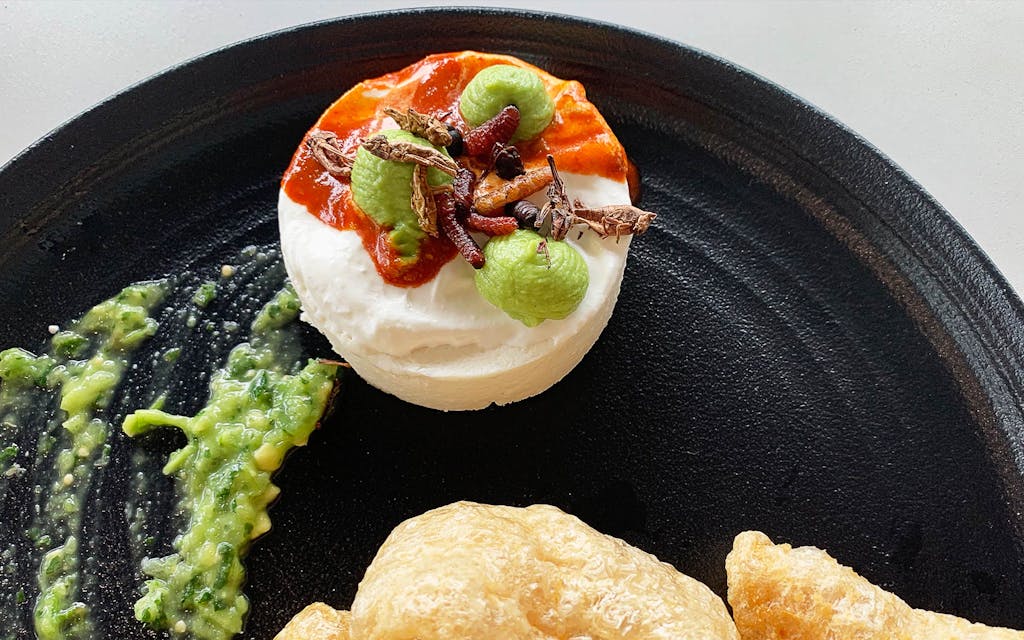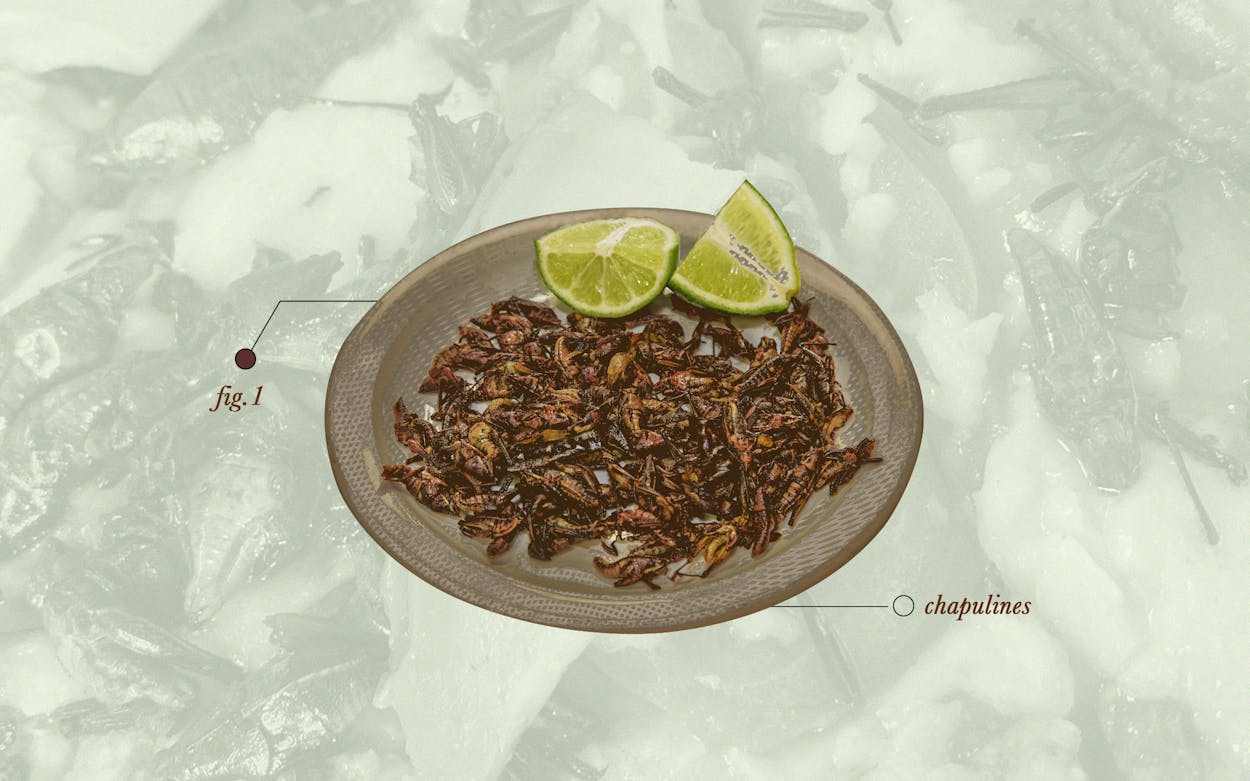The first time I ate chapulines, I bit off more than I could chew. The year was 2014, and the taqueria was El Come Taco in Dallas. Chapulines (the plural of chapulín) are dried and roasted grasshoppers, a pre-Hispanic Mexican delicacy. They are small—most are shorter than the length of an adult pinky—and nutty in flavor. The cooking process can add additional flavors, such as lemon, garlic, and chile. Often chapulines are eaten solo as a snack, or a taquero can generously pack a taco with them for a steep price (one Texas wholesaler sells them for $33 per pound; the price for one taco can be $4 or more). At El Come Taco, the taco I held was garnished with guacamole and a toasted, woodsy-scented pasilla salsa. The excitement was too much. Before I realized what I had done, I had half a bug taco in my mouth. My cheeks looked like inflated water balloons at a five-year-old’s birthday party. It was incredible.
I was giddy about the crunchy textures playing against the cool, smooth guacamole and the salsa that coated almost every other component. An extra spritz of lime brightened up the dish. One minute, two minutes, even three minutes in, though, and I was still chewing. I couldn’t break down the taco into swallowable portions. Grasshopper legs were wedged between my teeth. Abdominal sections were trapped beneath my tongue. I was in trouble. I reached for a beer and took the biggest swig possible to gulp down the food. My friends, including Texas Monthly barbecue editor Daniel Vaughn and the taqueria owner, Luis Villalva, laughed at me. Yet I wouldn’t change a thing about that experience. I realized then that I was munching on a fantastic traditional Mexican food that was poised for stateside ascendency.
Chapulines are still a rarity on most Texas restaurant menus, but that’s starting to change. Diners are opening their minds and palates to new flavors (huitlacoche or birria ramen, anyone?), and chapulines are a healthy snack with a “wow” factor. Their improved profile also coincides with a push for incorporating insects into diets, as bugs are high in protein and low in fat. Eating insects makes sense from a climate-change perspective too. Chapulines are the future, according to the many trend stories that have been published on the subject in the last few years. And if you think Americans aren’t ready to join the two billion people around the globe who already eat bugs, think again: In 2017, Seattle Mariners baseball fans queued up in long lines to try chile-lime chapulines at the stadium. Coverage of the snack, which is still a best-seller, upstaged news of the team. I’ve yet to sample chapulines at a ballpark, but I’ve enjoyed them while strolling through an outdoor market, where you can often find them sold in a modestly sized snack bag, tossed with salsa and lime juice. They’re also a great accompaniment to mezcal at a bar or restaurant, where they’re sometimes served in a ramekin. Chapulines are a fantastic munchie, regardless of their nutritional benefits.

Whether or not nutritious bugs are really the future of food, for many Mexicans they were the past and are the present. Mesoamericans consumed chapulines before the Spanish conquest. They began as a necessity, and continue to be a staple of regional diets, especially in Oaxaca and up through central Mexico. Historically, chapulines have been harvested in alfalfa fields from spring to early fall via special nets or by hand. Recently, though, they have become a year-round commodity.
At El Come Taco, Villalva introduced chapulines seven years ago. He considers it his mission to expose customers to the wide realm of Mexican gastronomy. “It’s part of our culture,” he says. Villalva is also a savvy businessman who wanted to distinguish his place from the myriad other taco operations in Dallas: “I wanted to sell something that was hard to find and other restaurants might be afraid of selling.” It worked. The chapulines gained a small but loyal following. Their popularity has also shown other Texas taqueria owners that the critters are worth serving. At Revolver Taco Lounge, they are an appetizer. Los Oaxaqueños in Oak Cliff serves them on pizza. Its now-defunct predecessor, Mi Lindo Oaxaca, served them on memelas, or toasted, oval-shaped corn cakes; in tacos; and in tlayudas. They can also be ground into salsas.
Nevertheless, nearly a decade later, the lime, chile, and garlic–seasoned tacos de chapulines at El Come Taco still have their skeptics. “Why would you sell that? How do you eat that?” customers have asked Vilallva. He sometimes fires back with a one-liner: “After two to three days without eating anything, you’ll wish you had one of these.”
It’s a different experience at the six-month-old La Fonda de Jaime 2.0 taco truck in San Antonio, where chapulines are employed judiciously as a garnish. Owner and chef de cuisine Jaime Hernandez sprinkles them on his carne asada tacos. These aren’t your average beef tacos. The asada is grilled over a mixture of mesquite and applewood for a smoky aroma and finish. The tacos also get topped with greens and grilled onions, and everything is served on handmade corn tortillas. The addition of chapulines signals that these tacos are special—and Hernandez regularly hears as much from customers. “White, Black, Mexican—a lot of people say, ‘I don’t like to be open-minded, but the chapulines change my life,’” he says. “They beg me to put them on all the tacos. But if I put chapulines on everything, they are no longer special.”

Hernandez sources his chapulines from Houston-based importer Agropa LLC. Owner José Leyva, whose company is popular with some of Texas’s finest Mexican restaurants and chefs, ships the product from Oaxaca state. At first he imported the insects only seasonally—in the summer and fall, when the insects mature and grow in size. Now, Agropa keeps up with the increasing demand by supplying restaurants and other clients with monthly orders. Yet, when he talks about chapulines, he starts with childhood reminiscences of his native Oaxaca City. “You can sit down with your family, maybe having a carne asada together for lunch. There’s always chapulines on the table,” Leyva says. Currently, he works with a variety of restaurants, Mexican and otherwise, across Texas as well as in Miami and Los Angeles. It’s through companies like Agropa and restaurants like El Come Taco, Houston’s Xochi, and La Fonda de Jaime 2.0 that chapulines have even gained a gourmet aura. In the first episode of Netflix’s The Final Table, a chef-contestant wrapped a chapulín in edible gold to show “the beauty and the nobility of the insects.”
What’s more, at least one high-end Mexican brand has established a nursery where chapulines are grown not just in alfalfa fields but also in corn and sesame fields, Leyva says. When grasshoppers consume the seeds, they take on a nuttier flavor. After harvesting, the insects are dried via industrial solar power, seasoned, packaged, and shipped to stores and consumers across Mexico and the U.S. Chapulín farming has also expanded outside Mexico to countries such as Israel. You can even buy them on Amazon. That’s how accessible the down-to-earth delicacy has become. But before you commit to a large order, a word of advice: support your local taqueria first.
Where to Try Chapulines in Texas
El Come Taco
2513 N. Fitzhugh, Dallas
The tacos de chapulines are served with silky guacamole and smoky pasilla salsa.
La Condesa
400 W. Second, Austin
Chapulines get another appetizer treatment with guacamole and a tomatillo-based salsa.
La Fonda de Jaime 2.0
206 Brooklyn, San Antonio
The grasshoppers’ nuttiness amplifies the wood-grilled carne asada taco’s flavor.
Xochi
1777 Walker, Houston
A chapulín or two join other edible insects as a garnish for the fresh cheese and chicharrones appetizer.
- More About:
- Tex-Mexplainer
- Tacos
- Mexican Food
- San Antonio
- Houston
- Dallas








